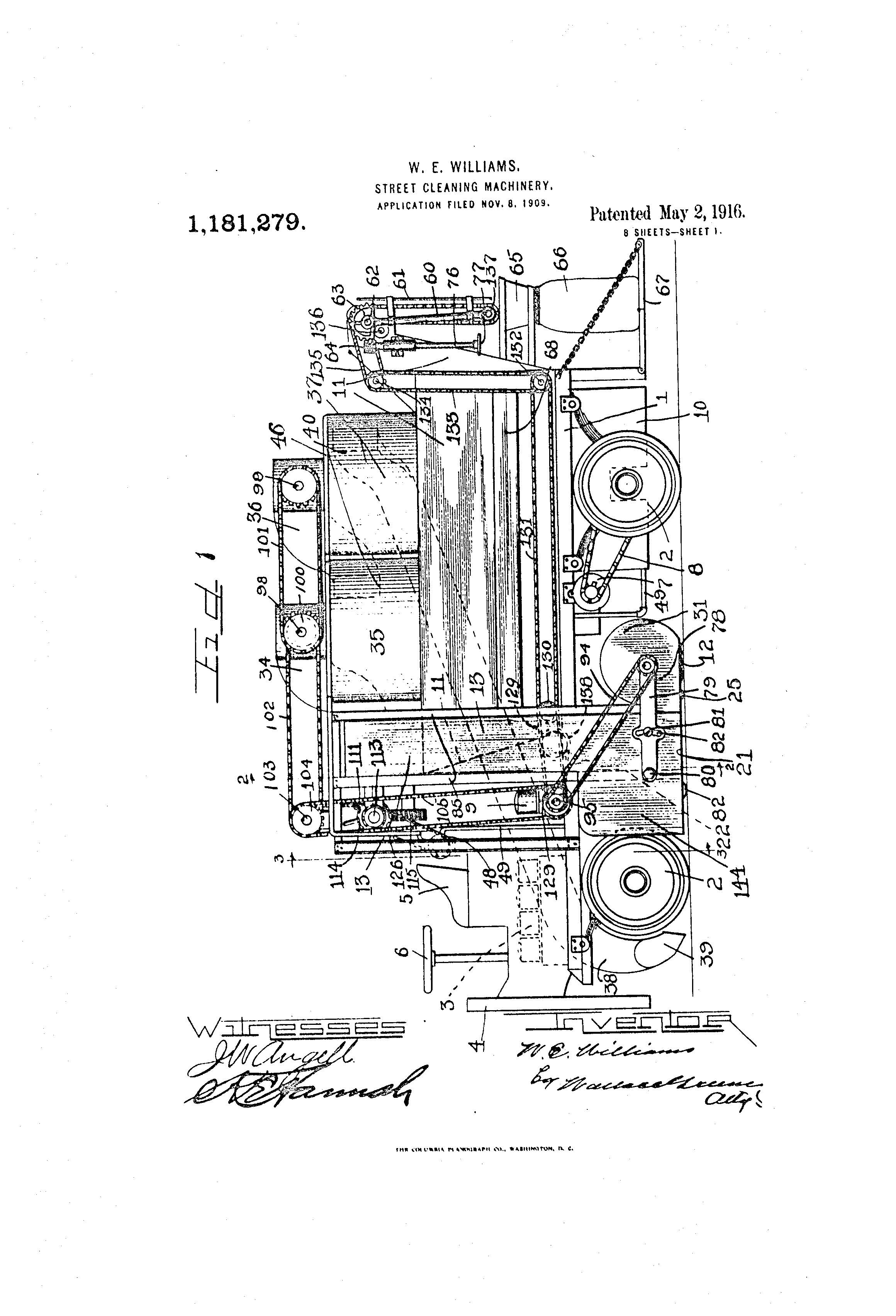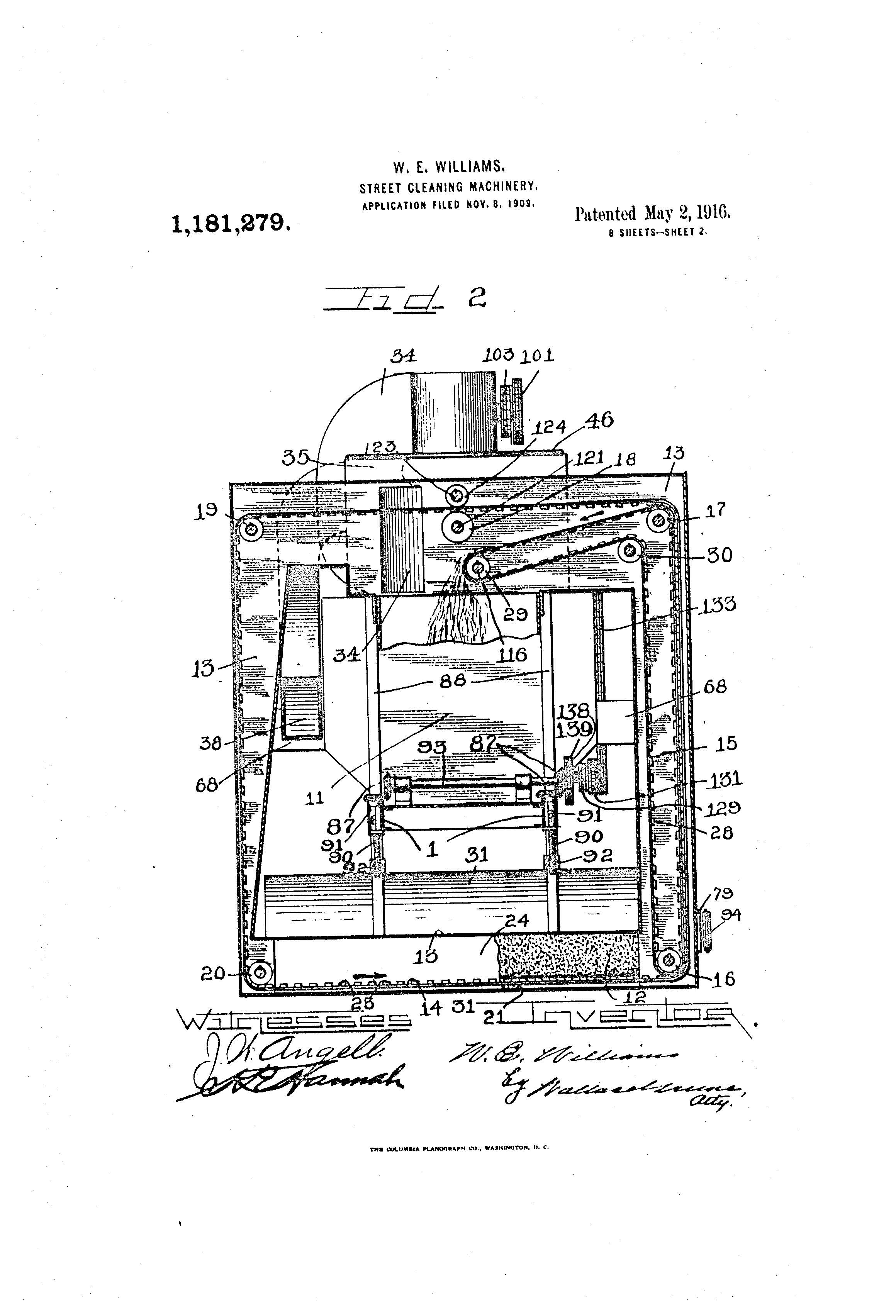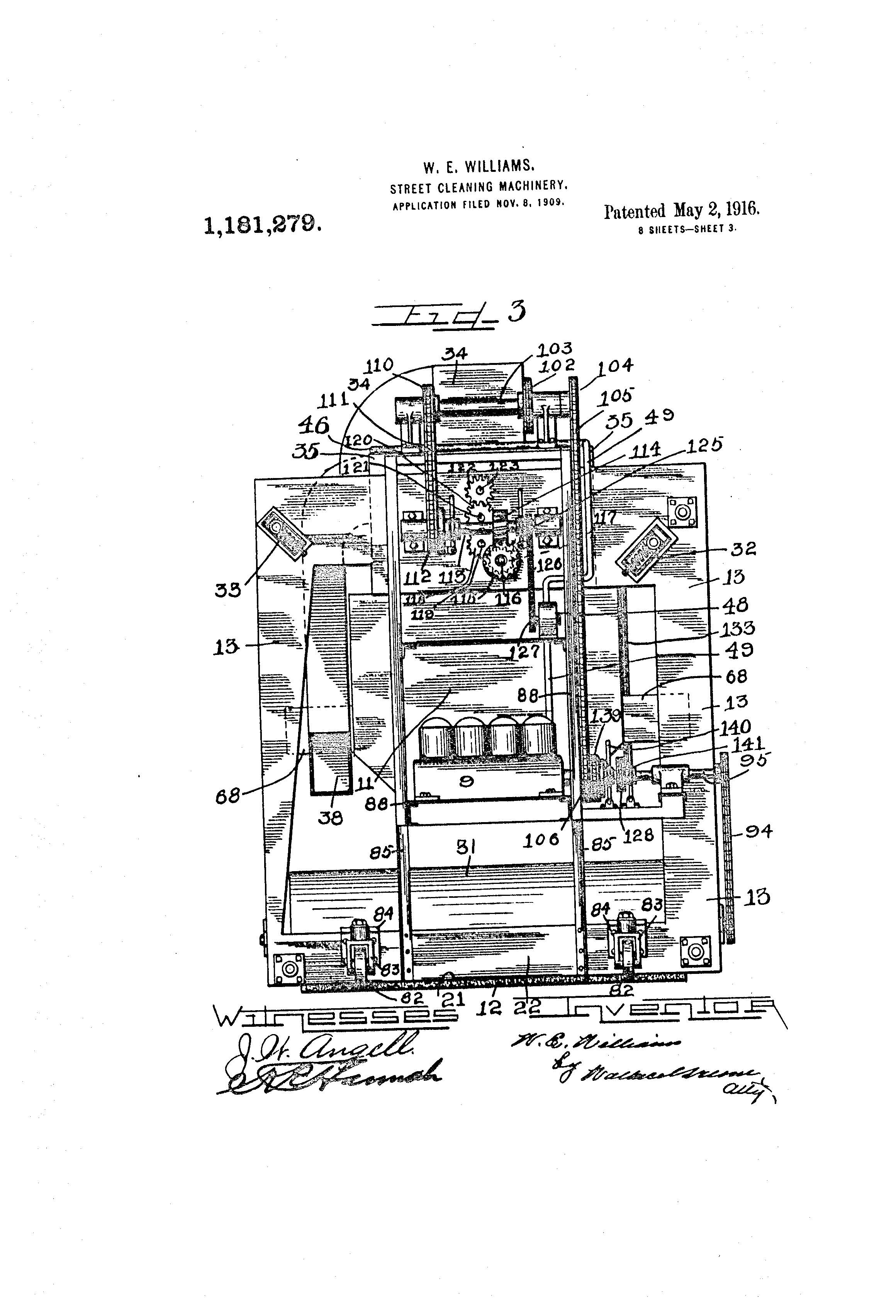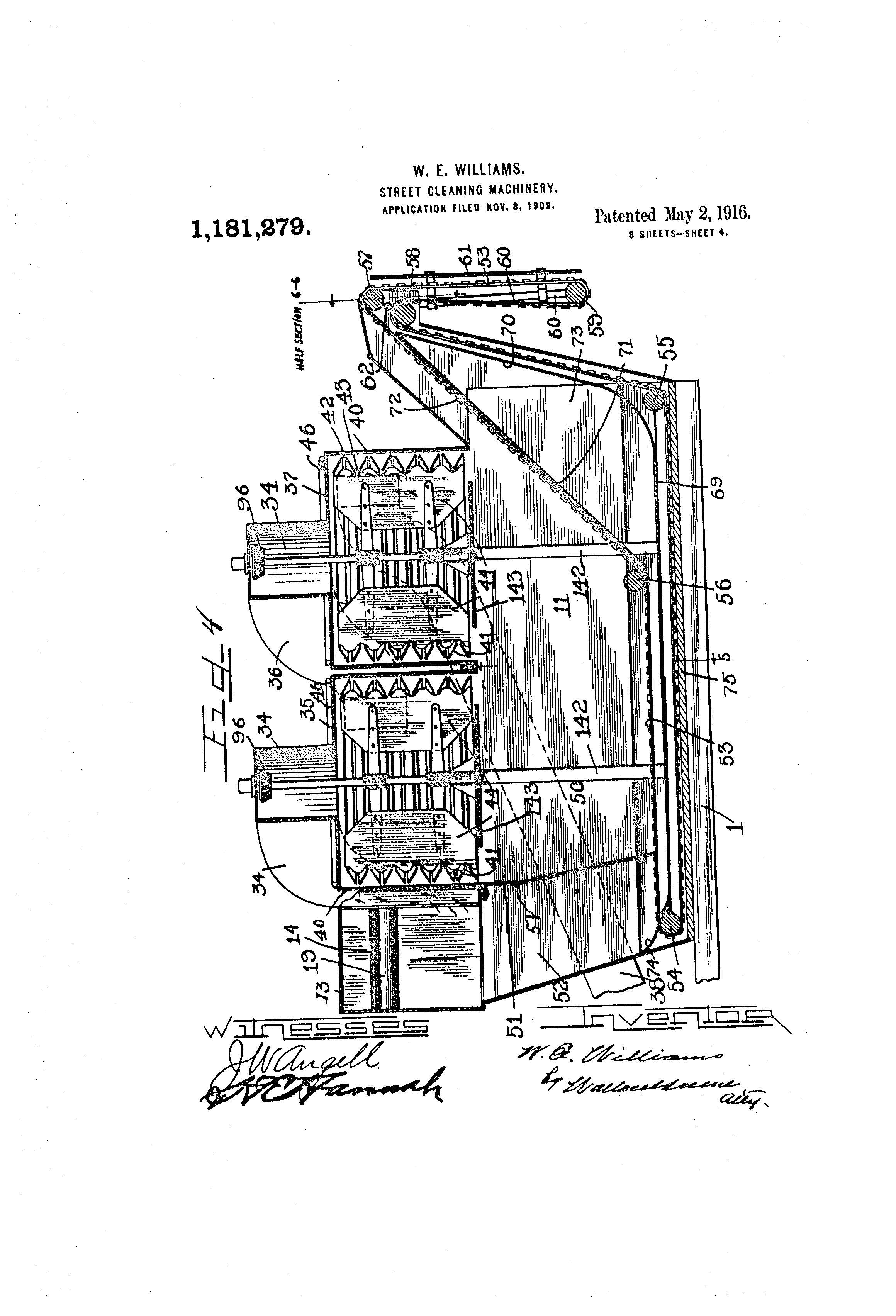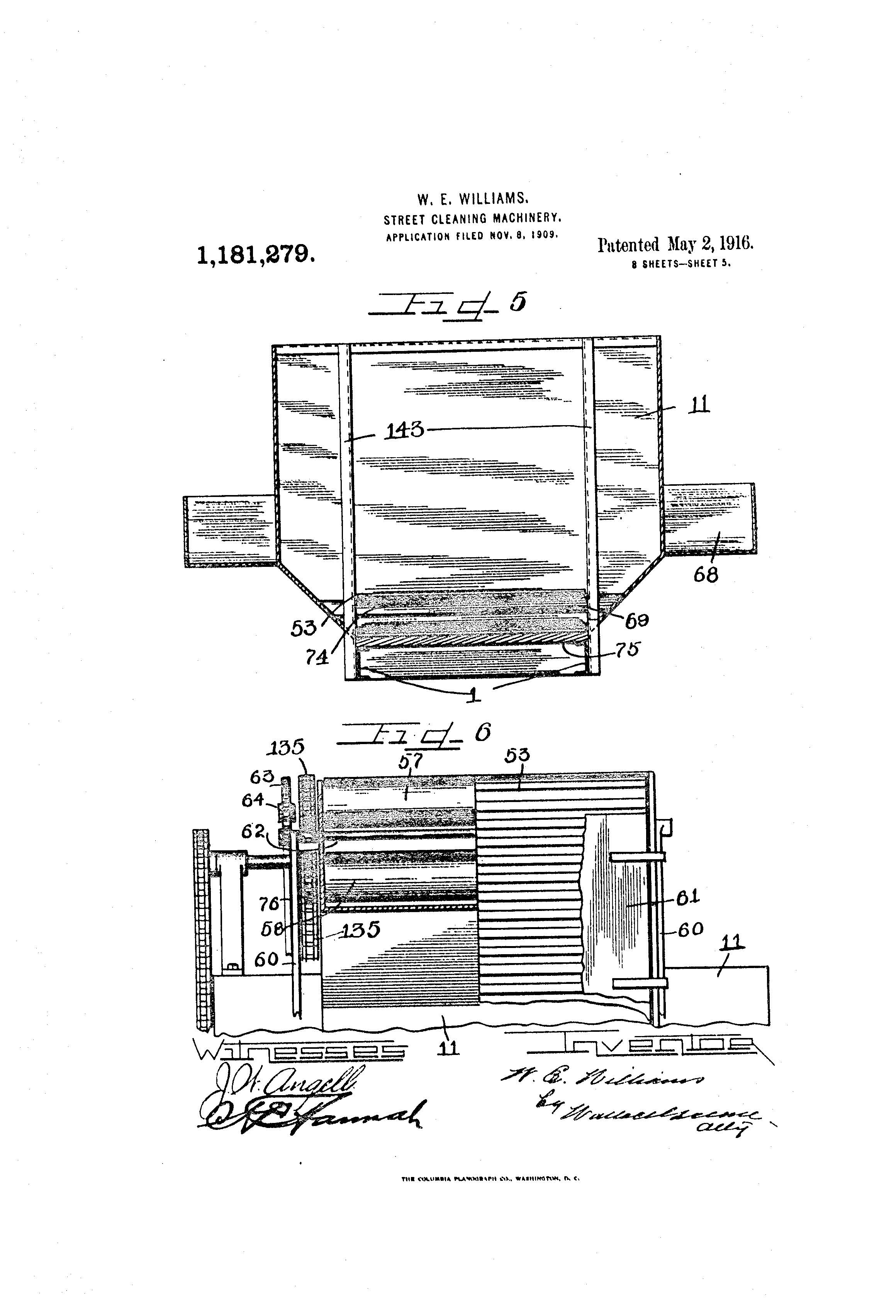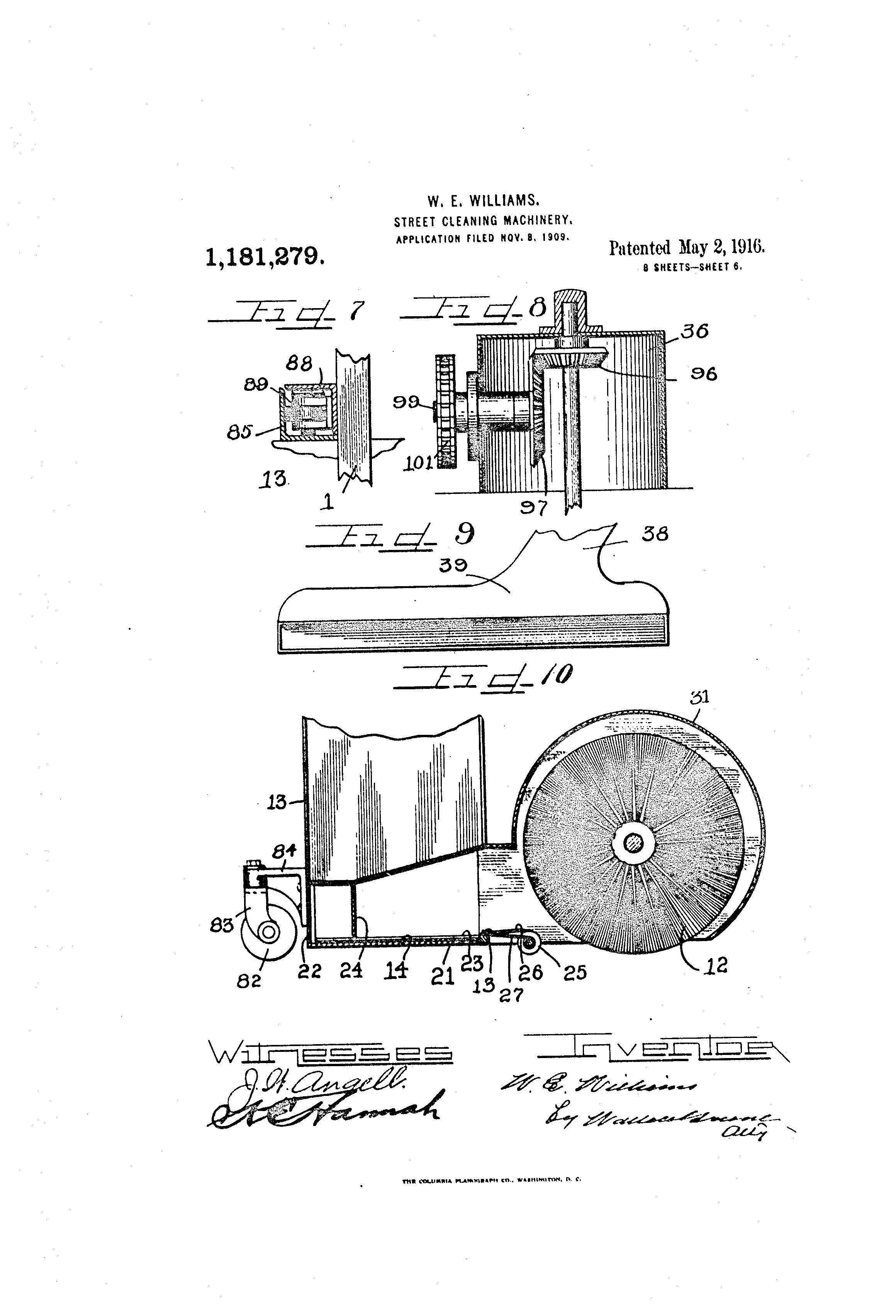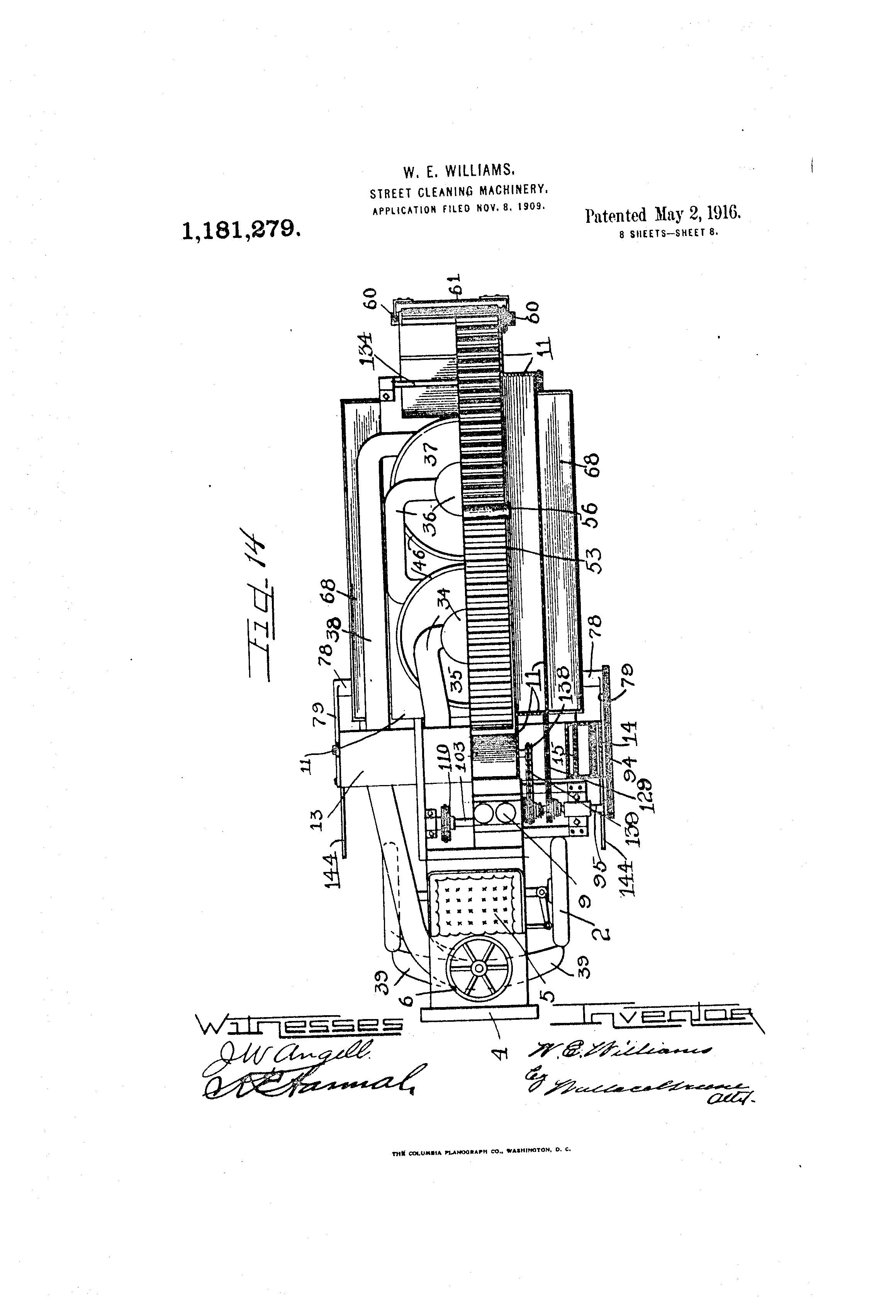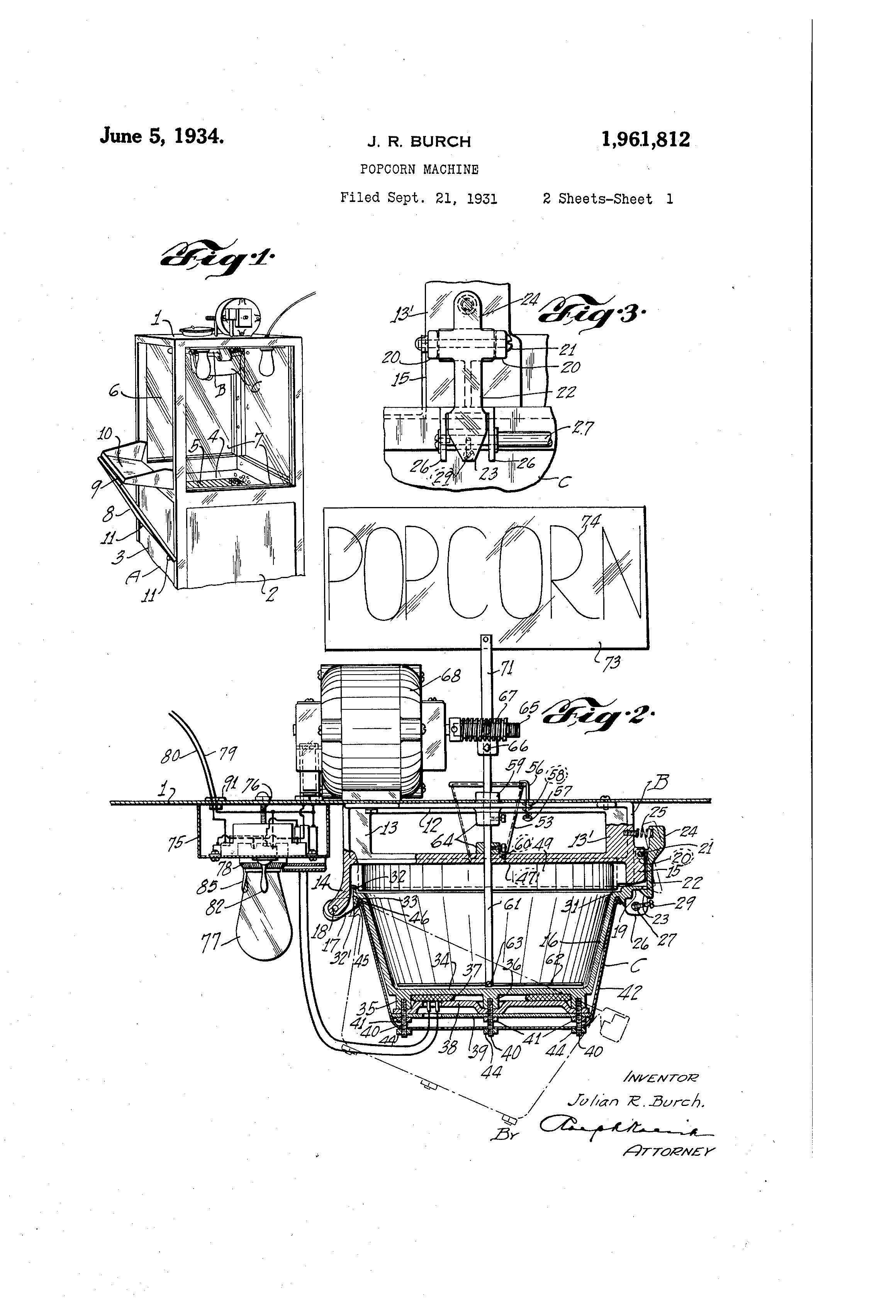Patent of the Day: Basketball Shoes
Suiter Swantz IP takes a look back at past inventions and inventors with our Patent of the Day.
On this day in 1934, John T. Riddell was granted U.S. Patent No. 1,962,526 for a BASKET BALL SHOE.
The main objects of the invention are to provide an improved and more serviceable shoe of the kind referred to and which shall have a rubber friction sole secured in a better way to an upper of leather, canvas or the like; to provide a rubber soled athletic shoe which shall have better drying and ventilating qualities than such shoes heretofore made; to provide for adequately securing rubber soles to uppers through the medium of a welt and appropriate stitching or the like in a permanent and readily feasible manner adapted to withstand the severe service strains imposed on basketball shoes; to provide positively against tearing out of the stitches or other fastenings from the sole; to provide against peeling or “rolling off” of the sole facing rubber; and to provide for such shoes a friction sole of superior and improved shape and better floor gripping qualities.
Suiter Swantz IP is a full-service intellectual property law firm serving all of Nebraska, Iowa and South Dakota. If you have any intellectual property questions or need assistance with any patent, trademark or copyright matters and would like to speak to one of our patent attorneys please feel free to contact us.
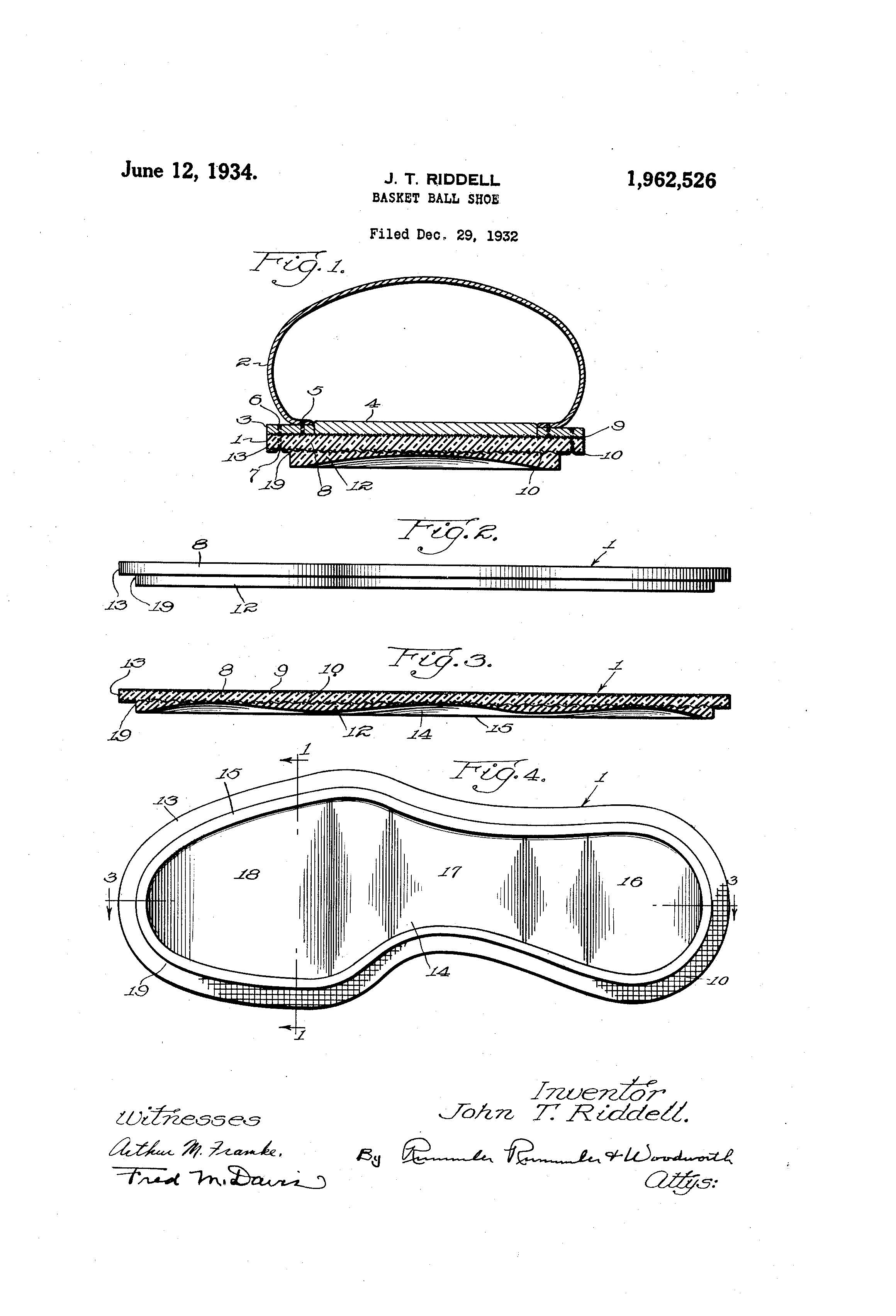
Patent of the Day: Apparatus and Method for Creating Three-Dimensional Objects
Suiter Swantz IP takes a look back at past inventions and inventors with our Patent of the Day.
On this day in 1992, S. Scott Crump was granted U.S. Patent No. 5,121,329 for an APPARATUS AND METHOD FOR CREATING THREE-DIMENSIONAL OBJECTS.
The invention is an apparatus incorporating a movable dispensing head provided with a supply of material which solidifies at a predetermined temperature, and a base member, which are moved relative to each other along “X,” “Y,” and “Z” axes in a predetermined pattern to create three-dimensional objects by building up material discharged from the dispensing head onto the base member at a controlled rate. The apparatus is preferably computer driven in a process utilizing computer aided design (CAD) and computer-aided (CAM) software to generate drive signals for controlled movement of the dispensing head and base member as material is being dispensed.
Three-dimensional objects may be produced by depositing repeated layers of solidifying material until the shape is formed. Any material, such as self-hardening waxes, thermoplastic resins, molten metals, two-part epoxies, foaming plastics, and glass, which adheres to the previous layer with an adequate bond upon solidification, may be utilized. Each layer base is defined by the previous layer, and each layer thickness is defined and closely controlled by the height at which the tip of the dispensing head is positioned above the preceding layer.
Suiter Swantz IP is a full-service intellectual property law firm serving all of Nebraska, Iowa and South Dakota. If you have any intellectual property questions or need assistance with any patent, trademark or copyright matters and would like to speak to one of our patent attorneys please feel free to contact us.
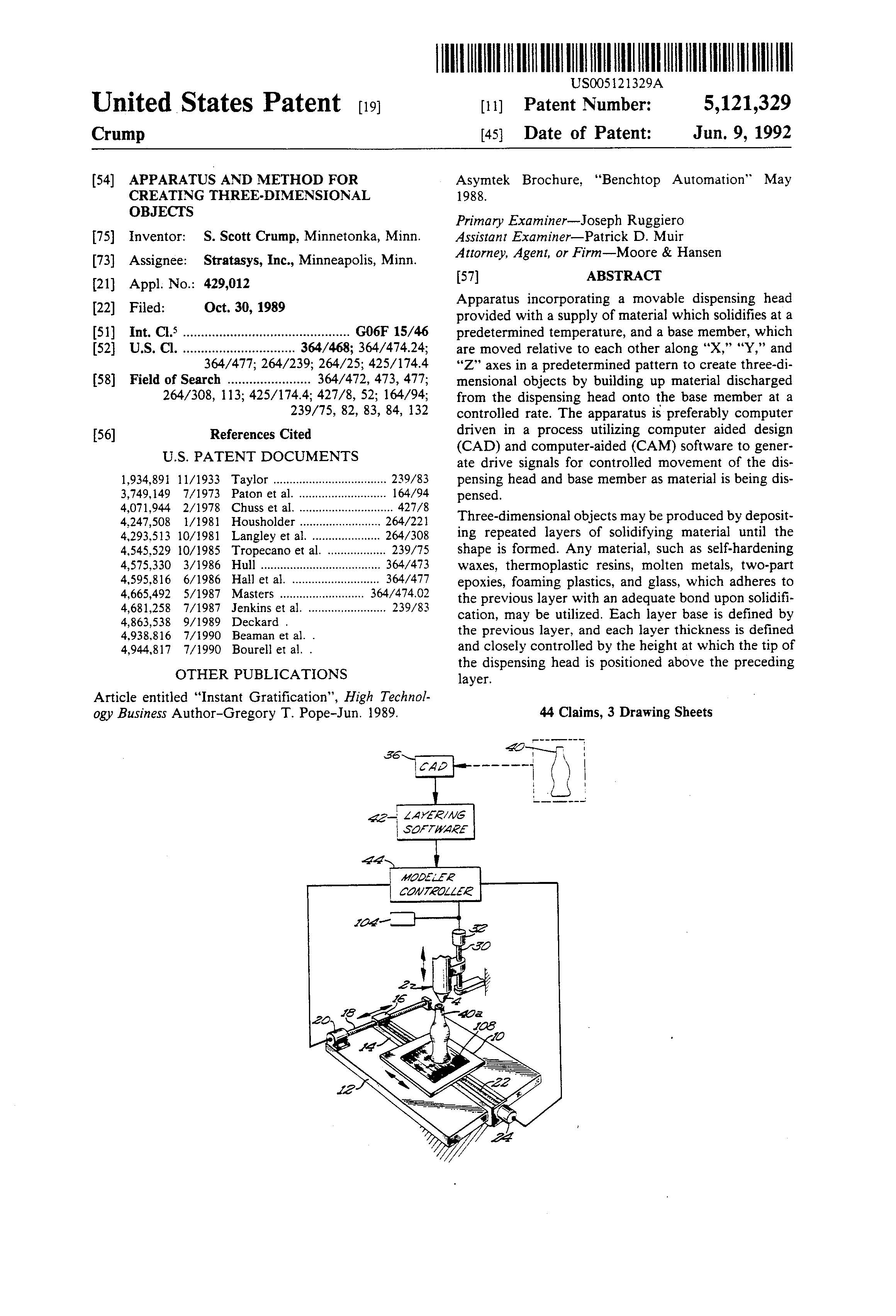
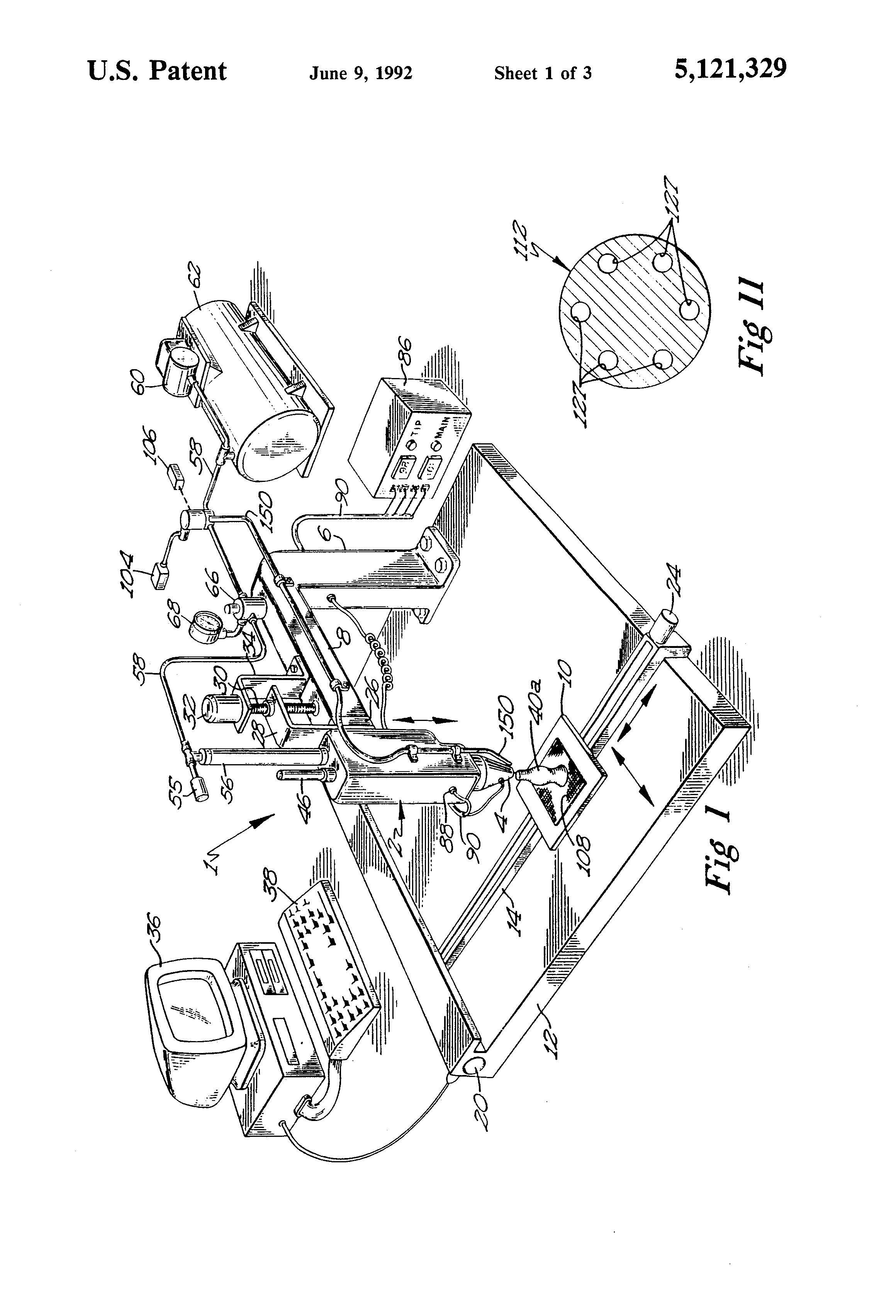
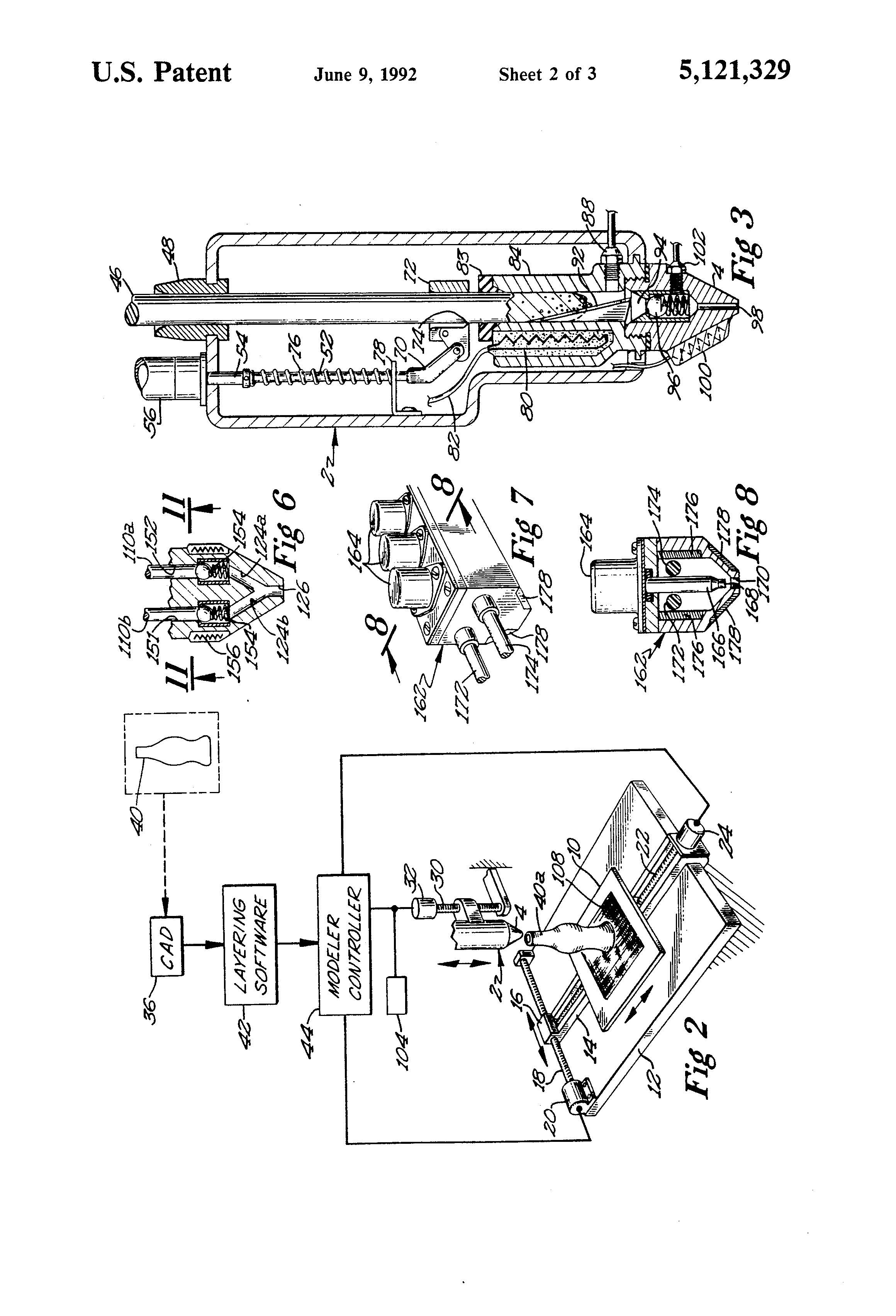
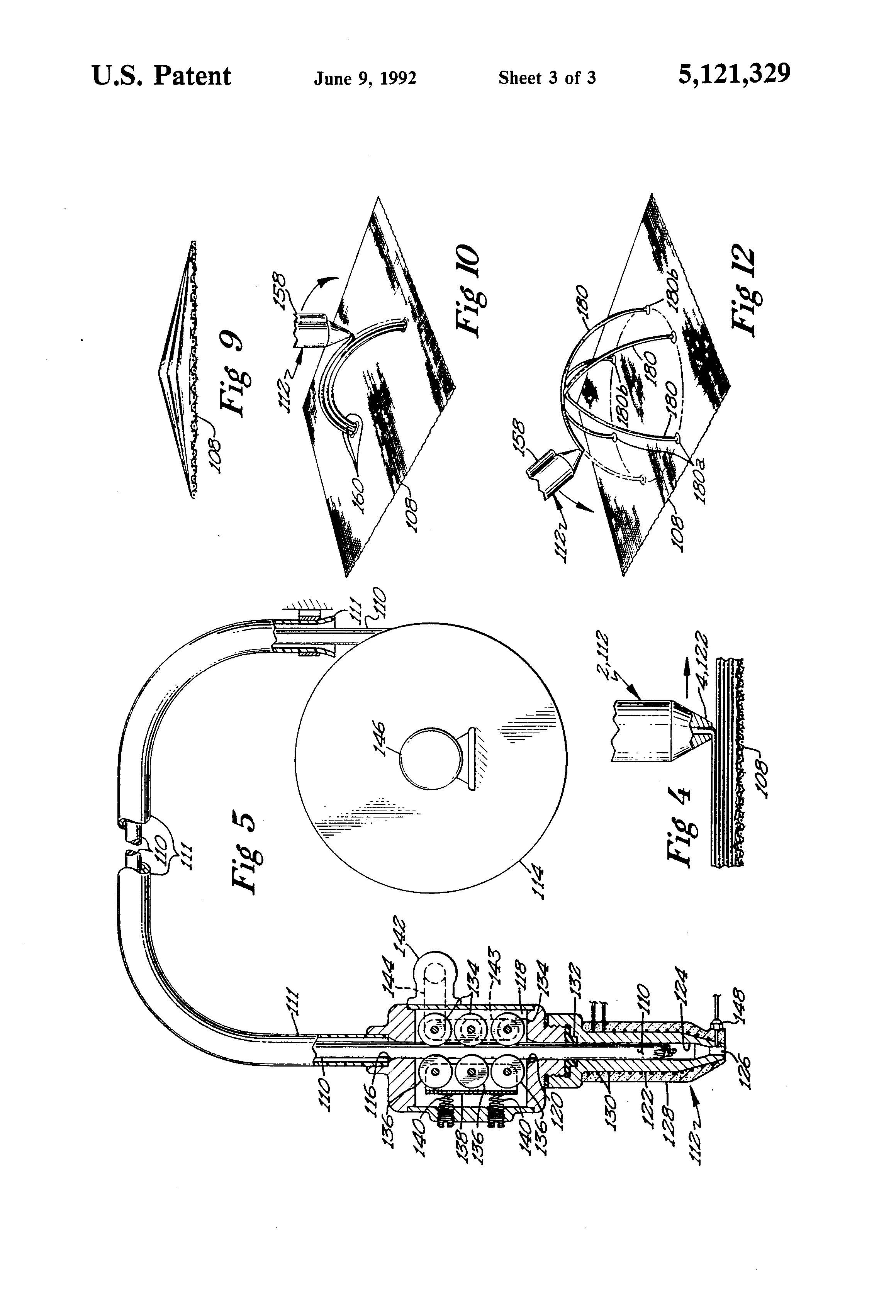
Patent of the Day: Improved Sweeping-Machine (Vacuum)
Suiter Swantz IP takes a look back at past inventions and inventors with our Patent of the Day.
On this day in 1869, Ives W. McGaffey was granted U.S. Patent No. 91,145 for an IMPROVED SWEEPING-MACHINE.
Before vacuum cleaners existed, people would take their carpets outside to beat the dirt out of them. In 1797, the broom was perfected in Massachusetts, and not long after people sought a better, less tedious, and more technologically advanced way to clean. In the 1850s, carpet sweepers that used a manual system of pulleys and cranks that rotated a brush or sweeping apparatus to push dirt into a receptacle were invented.
Chicago inventor Ives McGaffey patented the first device for cleaning rugs. He called his machine “Whirlwind”. His vacuum was difficult to use because the operator had to manually turn a crank while pushing it across the floor. McGaffey’s invention was not a motorized or electric vacuum cleaner, but it is known as the first hand-pumped vacuum cleaner in the United States. McGaffey is credited by many historians for the invention of the vacuum due to the hand-operated crank to produce power and the machine standing upright, resembling modern vacuum cleaners.
The accumulation of dust and dirt in dwelling-houses is a source of great annoyance to all good housekeepers, a large portion of the dust being so light that the ordinary process of sweeping sends it flying into the air, so that it is difficult to control or expel it from the room. The use of a broom or brush on carpets is objectionable, for it wears off the lint and fiber in fine particles, and creates a cloudy dust, while the heavier particles are brushed down into the carpet.
To obviate these difficulties is the object of McGaffey’s invention, the nature of which consists in the employment of a strong current of air, produced by mechanism, and so controlled as to take up the dust and dirt, and carry the fine particles into a porous air-chamber, so constructed as to allow the air to escape, while the dust is retained.
Vacuums have significantly advanced since McGaffey's invention. In 1901, Huber Cecil Booth patented the first motorized vacuum cleaner. His invention did not achieve much success as it required a horse-drawn carriage for transport. Many inventors introduced variations of Booth’s vacuum with a cleaning-by-suction contraption. In 1907, James Spangler used a broom, a pillowcase, and an electric motor to revolutionize the vacuum into a model similar to what we use today. William Hoover, a leather goods manufacturer, purchased the patent from Spangler, made improvements, and turned his invention into a business that is still successful today.
Suiter Swantz IP is a full-service intellectual property law firm serving all of Nebraska, Iowa and South Dakota. If you have any intellectual property questions or need assistance with any patent, trademark or copyright matters and would like to speak to one of our patent attorneys please feel free to contact us.
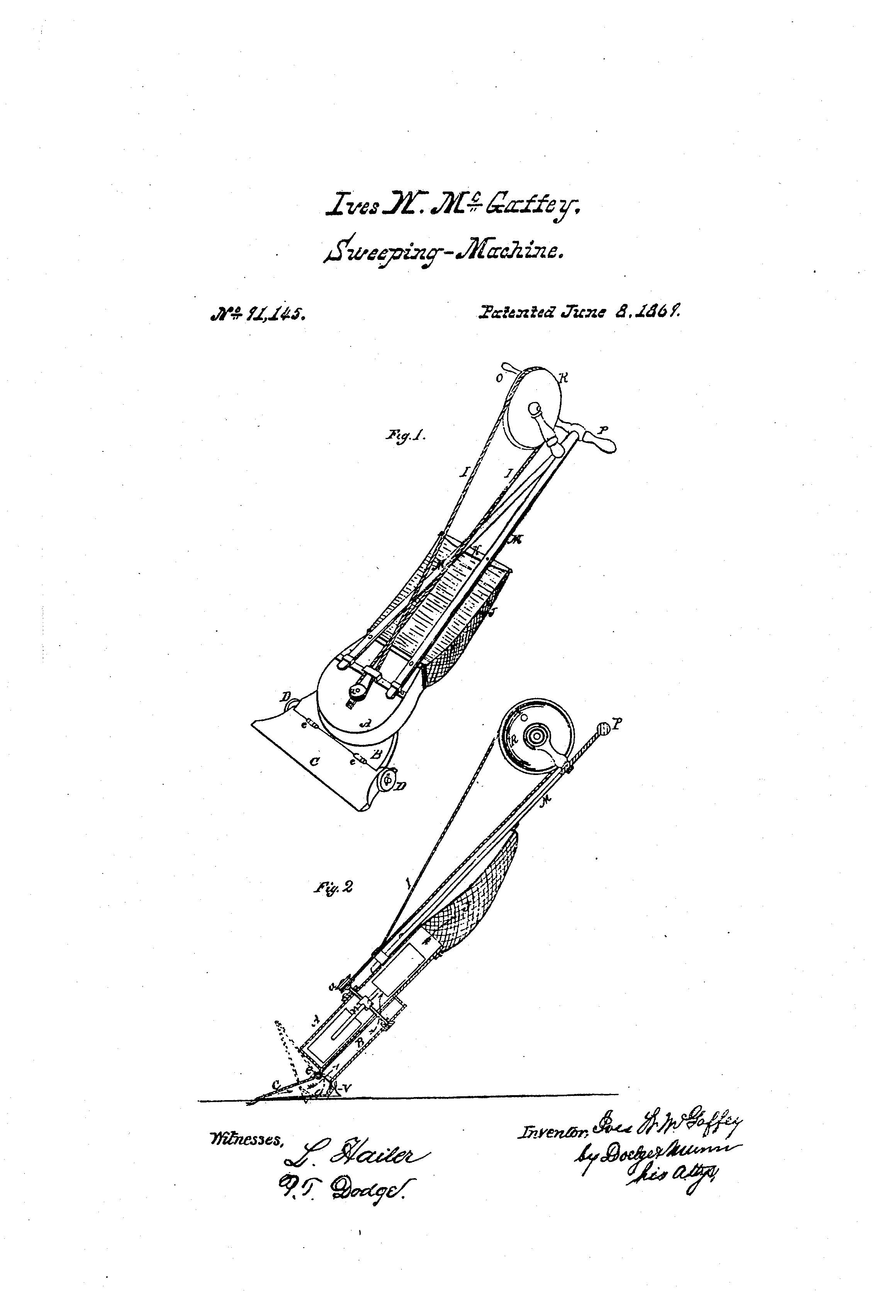
Patent of the Day: Garage Door Opener
Suiter Swantz IP takes a look back at past inventions and inventors with our Patent Of The Day.
On this day in 1930, Joseph T. Crawley was granted U.S. Patent No. 1,862,469 for a GARAGE DOOR OPENER.
An object is to provide a novel construction whereby latching means for garage doors may be moved to open position automatically upon the approach or through the travel of the automobile. Another object is to provide a novel construction whereby operative engagement between the door or doors and the operating means is established when the doors are returned to closed position. A further object is to provide a novel construction wherein a pedal operates a rod, provided with cranks at opposite ends, one being connected to the pedal and the other to the door latching means.
Suiter Swantz IP is a full-service intellectual property law firm serving all of Nebraska, Iowa and South Dakota. If you have any intellectual property questions or need assistance with any patent, trademark or copyright matters and would like to speak to one of our patent attorneys please feel free to contact us.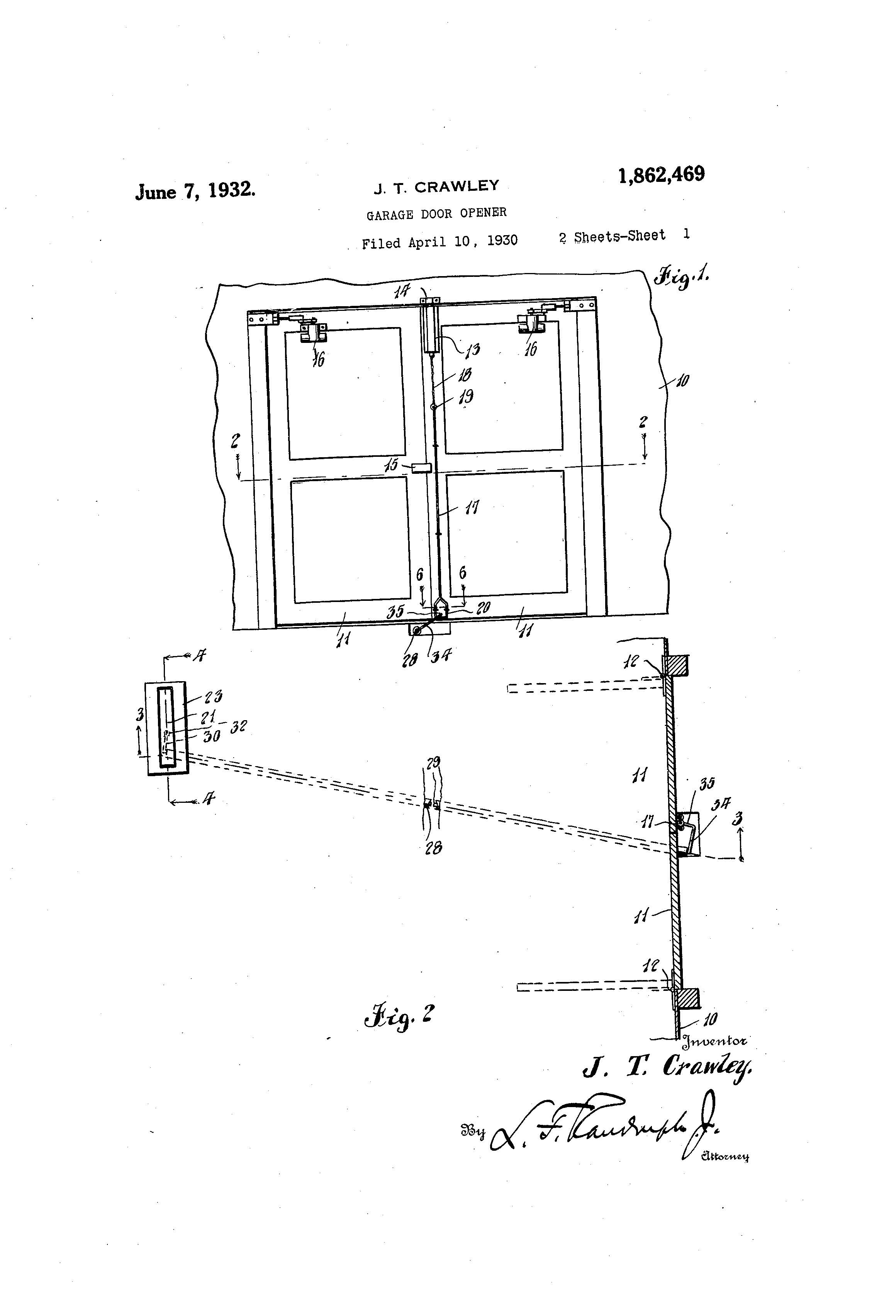
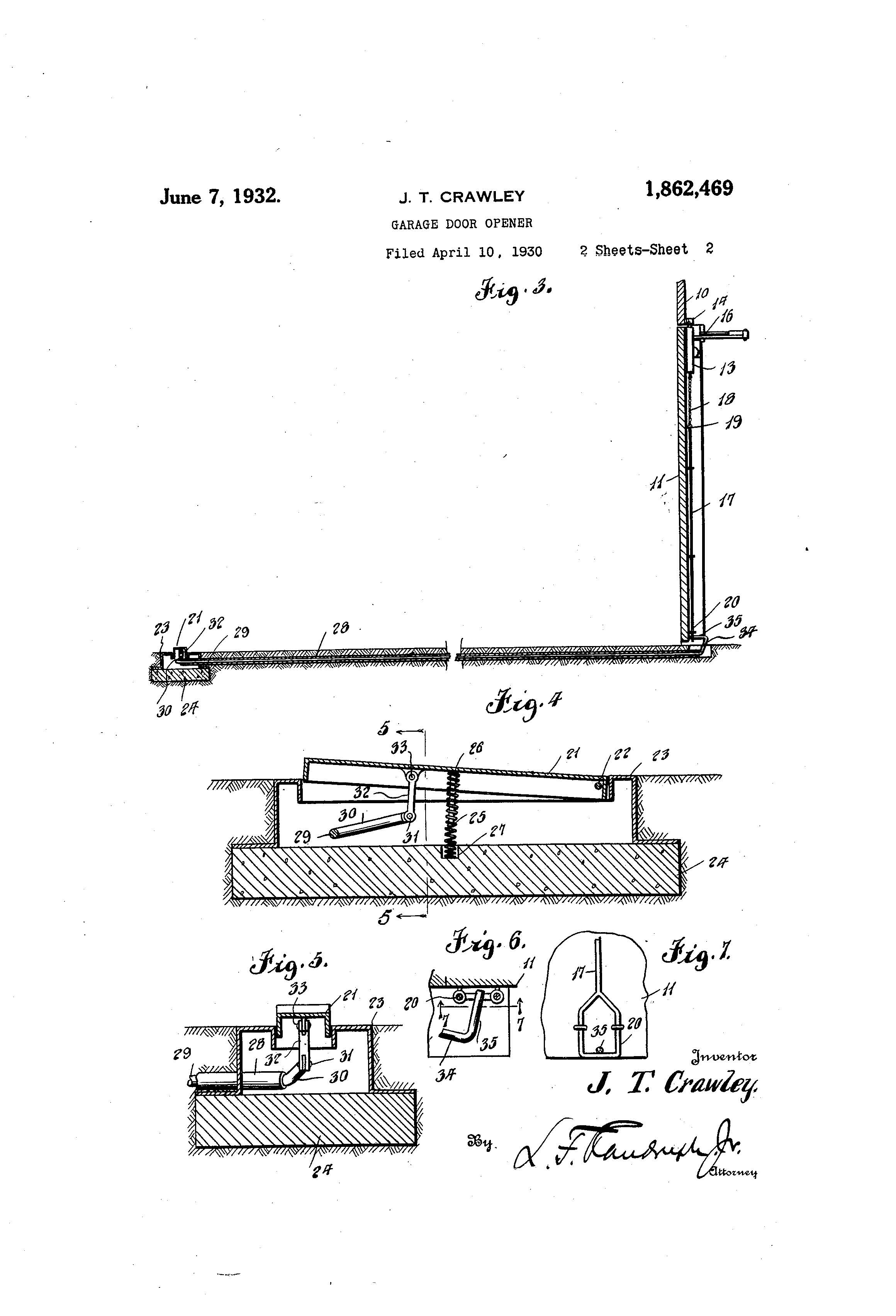
Patent of the Day: Electric Flat Iron
Suiter Swantz IP takes a look back at past inventions and inventors with our Patent Of The Day.
On this day in 1882, Henry W. Seely was granted U.S. Patent No. 259,054 for a ELECTRIC FLAT IRON.
Before electricity, many early civilizations were using hot, flat surfaces to smooth out fabrics and reduce creasing. Smoothing stones in the 8th and 9th centuries are known as the earliest western ironing devices. During the industrial revolution, early irons were filled with hot materials like coals or were placed directly in a fire until their surfaces were hot enough for use. In 1871, a model of iron with removable handles was introduced and marketed as “Mrs. Pott’s Removable Handle Iron.”
Henry W. Seely’s patented electronic iron and other early electronic irons developed around the same time used a carbon arc to create heat. The object of Henry W. Seely’s invention is to utilize electric currents derived from any suitable source of electric energy for the purpose of heating flat-irons, fluting-irons, and other similar utensils. To accomplish this object he placed within the iron and close to its face a resistance, preferably of carbon, and of such size and shape that it will heat the face of the iron sufficiently and equally. This resistance has terminals, by means of which it may be connected in an electric circuit, preferably a multiple-arc circuit of an electric lighting system. Unfortunately, for Seely and others who developed electric irons, this proved unsafe and commercially unsuccessful.
In 1892, hand irons using electrical resistance were introduced. Crompton and Co. and the General Electric Company pioneered this model and designed it to allow for the regulation of the heat in the iron. In 1926 the Eldec Company introduced the steam iron, this iron allowed heated water vapor to release the wrinkles of the material opposed the previous method of ironing damp clothes. It wasn’t until the early 1940s steam irons caught on in popularity and the 1950s is when the steam and dry combination iron, we are most familiar with was introduced.
Suiter Swantz IP is a full-service intellectual property law firm serving all of Nebraska, Iowa and South Dakota. If you have any intellectual property questions or need assistance with any patent, trademark or copyright matters and would like to speak to one of our patent attorneys please feel free to contact us.
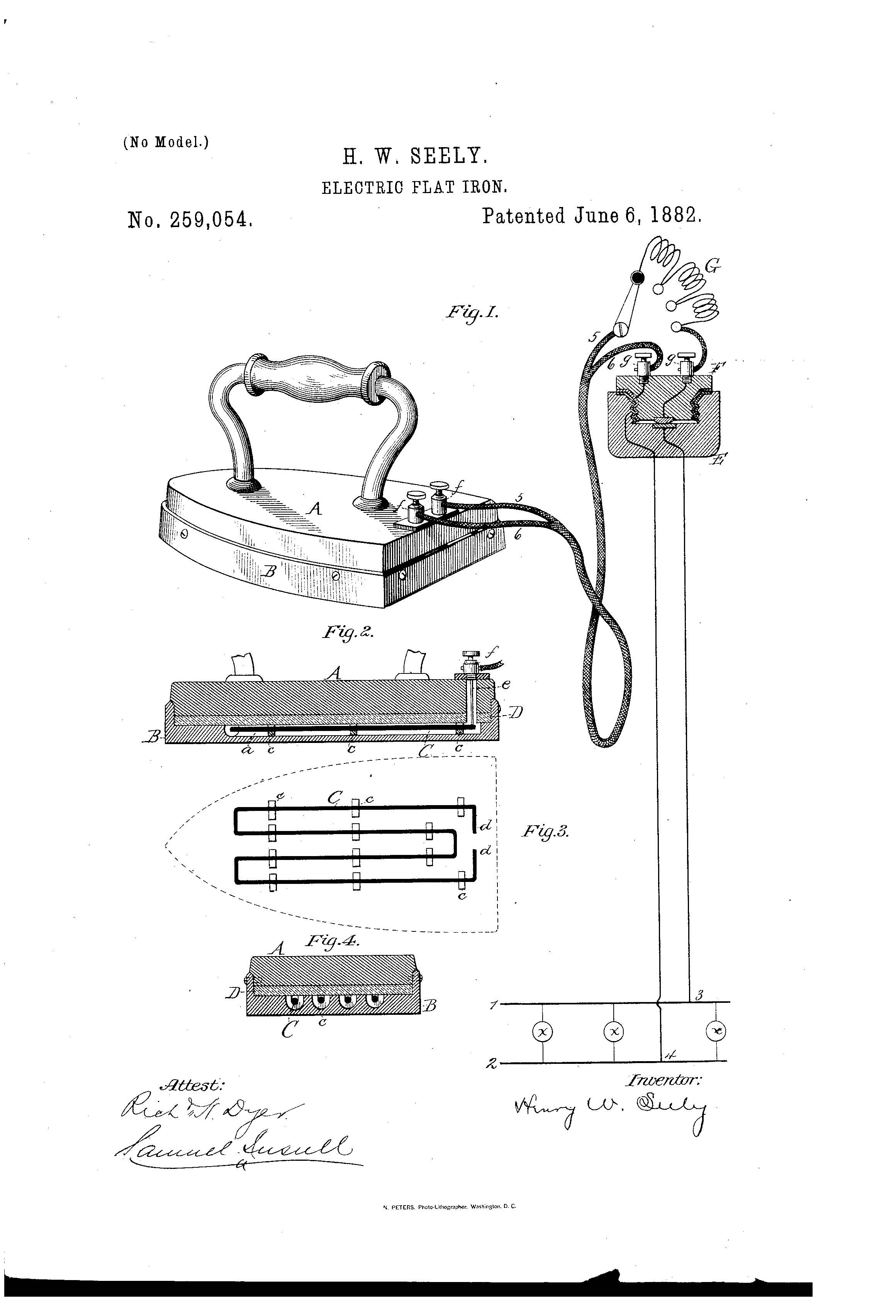
Patent of the Day: Popcorn Machine
Suiter Swantz IP takes a look back at past inventions and inventors with our Patent Of The Day.
On this day in 1934, Julian R. Burch was granted U.S. Patent No. 1,961,812 for a POPCORN MACHINE.
This invention has for one of its objects the provision in a machine of the character described of a popping-kettle incorporating means for enclosing the kettle for protecting the kettle bowl and its heating element from melted butter, grease, and the like, overflowing from the kettle interior during the popping of the corn and the subsequent discharge thereof from the kettle.
This invention for another object the provision in a corn-popping machine of a corn-popping kettle disposed in a suitable cabinet-chamber and having means for feeding corn to be popped to the kettle, such feeding means also serving as a vent for discharging to the atmosphere odors and gases arising from the kettle during corn-popping operations.
This invention has for still another object the provision in a popcorn machine of a swingable corn-popping kettle latchingly supported in a suitable cabinet-chamber, the kettle having a handle projecting in the chamber for co-operation with the kettle supporting latching means both for unlatching the kettle and for swingable manipulation thereof for discharging its contents into the cabinet-chamber.
This invention has for a further object the provision in a corn-popping machine of a kettle having a cover incorporating a kettle-communicating chamber for expansion there into of the popped corn rising in the kettle, thus increasing the popped-corn capacity of the kettle proper.
This invention has for a still further object the provision in a pop-corn machine of a kettle having a hingedly supported cover yieldable to pressure of the rising body of popped corn in the kettle for automatic overflow discharge of the surplus popped-corn product from the kettle.
This invention has for additional objects the provision of a corn-popping machine having a novel cabinet construction incorporating a foldable corn-chamber door adapted when open for disposition in shelf-like manner for substantially to increasing the corn-storage capacity of the corn-chamber of the cabinet, and to generally improve the construction of corn-popping machines.
Suiter Swantz IP is a full-service intellectual property law firm serving all of Nebraska, Iowa and South Dakota. If you have any intellectual property questions or need assistance with any patent, trademark or copyright matters and would like to speak to one of our patent attorneys please feel free to contact us.

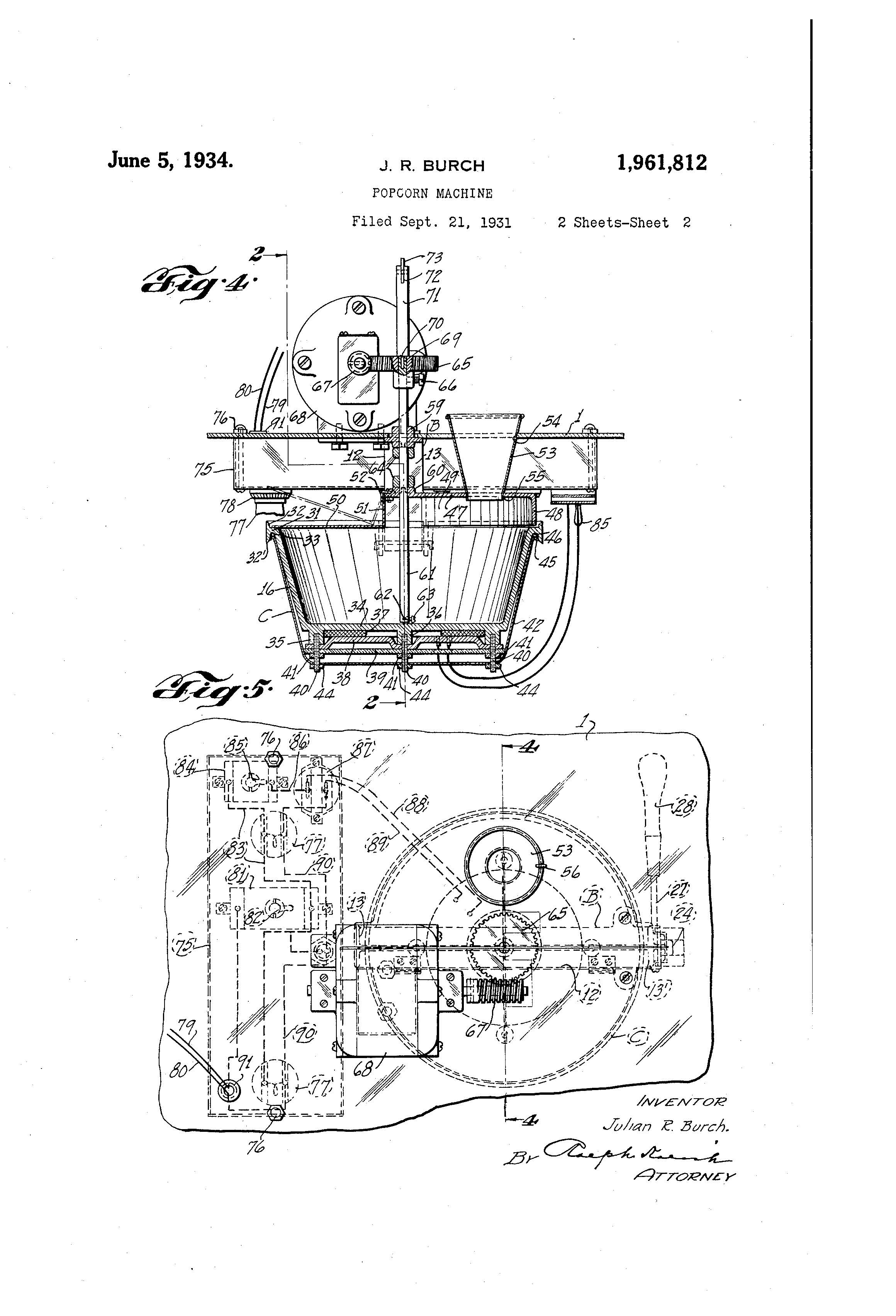
New Hires at Suiter Swantz IP
Suiter Swantz IP is excited to announce that Mitchell Ferris and Annmarie Ford have joined Suiter Swantz IP.
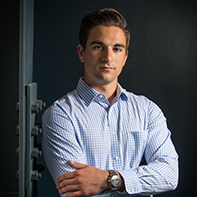 Mitchell joins the Firm as a Law Clerk and currently attends the University of Nebraska College of Law, where he serves as the Online Editor of the Nebraska Law Review. Prior to attending law school, Mitchell received his Bachelor’s degree in Chemical Engineering (BSCE) from the University of Nebraska-Lincoln. Mitchell will receive his Juris Doctor from the UNL College of Law in the Spring 2018.
Mitchell joins the Firm as a Law Clerk and currently attends the University of Nebraska College of Law, where he serves as the Online Editor of the Nebraska Law Review. Prior to attending law school, Mitchell received his Bachelor’s degree in Chemical Engineering (BSCE) from the University of Nebraska-Lincoln. Mitchell will receive his Juris Doctor from the UNL College of Law in the Spring 2018.
Outside of the office, Mitchell enjoys watching Husker football games, boating, wakeboarding, and snow skiing.
 Annmarie joins the Firm as a Marketing Intern and currently attends Creighton University. Annmarie will graduate with a BSBA with concentrations in Marketing and Finance in the Spring 2018. Annmarie is in the Dean's Fellows honors program and has made the Dean's Honor Roll for Social Responsibility every semester.
Annmarie joins the Firm as a Marketing Intern and currently attends Creighton University. Annmarie will graduate with a BSBA with concentrations in Marketing and Finance in the Spring 2018. Annmarie is in the Dean's Fellows honors program and has made the Dean's Honor Roll for Social Responsibility every semester.
Outside of the office, Annmarie is the Vice President of Chapter Operations for Alpha Phi Sorority at Creighton. She also serves in several leadership positions at Creighton and participates in a variety of intramural activities.
Please join us in welcoming these two great additions to the Suiter Swantz IP team!
Rocky Mountain Intellectual Property & Technology Law Institute
Suiter Swantz IP Attorneys Shane Thielen and Jon Horneber will be attending the 15th Annual Rocky Mountain Intellectual Property & Technology Law Institute CLE June 1-2.
This CLE will be about all the major developments in intellectual property and tech law, at one of the nation's largest gatherings of IP and tech law professionals.
The event will be held at:
Westin Westminster Hotel
10600 Westminster Blvd., Westminster, CO 80020
To read more about this event click here.
Uber and Lyft Sued for Patent Infringement over 18-year-old Patent
Los Angeles based Hailo Technologies LLC, which also operates under the name Bring, has sued both Uber and Lyft separately over alleged patent infringement of U.S. Patent No. 5,973,619, entitled Automated Vehicle Dispatch and Payment Honoring System. This patent, filed by Alexis Paredes in 1997, and granted in 1999, relates to a “computerized system with specialized software which enables a user to select a particular Taxi or vehicular transport company from a menu, along with the desired destination and number of passengers traveling.” In addition to these features, the Hailo system also gives the user an estimate of the fare and the available payment options based on the vehicle service company chosen.
Uber and Lyft famously use smartphone and app technology for their ride-sharing services. Hailo does not claim to have invented smartphone-based ride-sharing services altogether as such technology was not available 18 years ago when Hailo patented their system. Rather, the lawsuit’s focus is around the methods used to obtain an idea. In the complaint, Hailo stated their system is "[a] method as implemented on a computer system for use by a consumer, said method for delivering instructional messages to said consumer regarding private transportation companies and estimated costs for hiring said transportation company for transporting said consumer to listed destinations.” The steps involved when using Hailo’s system include the following: (1) the system locates the taxi/vehicle company and displays it for the user to select; (2) the system prompts the user to insert the number of passengers; (3) the user chooses a destination based on a graphic illustration; (4) the fare estimate is displayed based on the number of passengers and destination along with alternative forms of payment accepted by the vehicle service; (5) the call is placed for the ride service to be dispatched; (6) the arrival time of the vehicle is estimated.
Hailo alleged the methods in which Uber and Lyft users request a ride is almost identical to process executed by their system. Hailo detailed how both Uber and Lyft allow a user to select a vehicle from a graphical illustration based on the vehicle’s proximity to the user. The Uber and Lyft systems (according to Hailo) then prompt the user to enter the number of seats needed. Both systems provide a fare estimation and payment option. Once the user hits request on the app, a graphical illustration displays the estimated arrival time of the vehicle along with a real-time graphical display of the vehicle in comparison to the user.
It is important to note that an alleged infringer need only execute all of the steps/components of a patent holder’s claims in order to commit patent infringement. It is not the case that a patent need to discuss all of the various features performed by would-be infringers, in this case Uber and Lyft, in order to commit patent infringement. The key questions are i) whether Uber and Lyft performed all of the steps/components contained within the claims of the Hailo patent and; ii) whether, ultimately, the Hailo patent is valid.
Unfortunately for Uber this is not the only intellectual property dispute they are involved with. Uber was recently in the news as they were sued by Waymo, the Alphabet subsidiary now handling Google’s self-driving car project. We previously wrote that the lawsuit filed by Waymo alleged Otto, a self-driving truck company, purchased by Uber, stole trade secrets from Google. In the lawsuit, Waymo purported that former Google employee, Anthony Levandowski, downloaded over 14,000 highly confidential and proprietary design files related to Waymo’s various hardware systems and absconded with them when he left for Otto.
It will be interesting to see how these cases play out, especially since it has been reported that Waymo is teaming up with Lyft, Uber’s direct competitor, to test autonomous vehicles.
Suiter Swantz IP is a full-service intellectual property law firm serving all of Nebraska, Iowa and South Dakota. If you have any intellectual property questions or need assistance with any patent, trademark or copyright matters and would like to speak to one of our patent attorneys please feel free to contact us.
Claims to Graphic User Interface Upheld by Court as Relating to Eligible § 101 Subject Matter
On January 18, 2017, the United States Court of Appeals for the Federal Circuit (CAFC) issued a non-precedential opinion in Trading Technologies International, Inc. v. CQG, Inc. The CAFC affirmed the district court’s decision that graphical user interface (GUI) claims directed to a financial trading system are patent eligible under 35 U.S.C. § 101. The district court declared, “the claims require a specific, structured graphical user interface paired with a prescribed functionality directly related to the graphical user interface’s structure.”
This dispute originated with Trading Technologies International, Inc. asserting CQG, Inc. infringed the two U.S. Patent Nos. 6,772,132 and 6,766,304 that have the same specification. The CAFC stated the two challenged patents, “describe and claim a method and system for electronic trading of stocks, bonds, futures, options and similar products.” CQG asserted that the claims of these patents were directed to patent ineligible subject matter and moved for judgement as a matter of law. The district court denied CQG’s motion and CQG appealed in Federal Circuit, No. 2016-1616.
The CAFC states, “the patents explain problems that arise when a trader attempts to enter an order at a particular price, but misses the price because the market moved before the order was entered and executed.” The challenged patents are for “[a] method and system for reducing the time it takes for a trader to place a trade when electronically trading on an exchange, thus increasing the likelihood that the trader will have orders filled at desirable prices and quantities.”
The patents were reviewed for patent eligible subject matter in terms of 35 U.S.C. § 101 and the CAFC illustrated analysis of § 101 eligibility with respect to method claim 1 of the’304 patent:
1. A method for displaying market information relating to and facilitating trading of a commodity being traded in an electronic exchange having an inside market with a highest bid price and a lowest ask price on a graphical user interface, the method comprising;
dynamically displaying a first indicator in one of a plurality of locations in a bid display region, each location in the bid display region corresponding to a price level along a common static price axis, the first indicator representing quantity associated with at least one order to buy the commodity at the highest bid price currently available in the market;
dynamically displaying a second indicator in one of a plurality of locations in an ask display region, each location in the ask display region corresponding to a price level along the common static price axis, the second indicator representing quantity associated with at least one order to sell the commodity at the lowest ask price currently available in the market;
displaying the bid and ask display regions in relation to fixed price levels positioned along the common static price axis such that when the inside market changes, the price levels along the common static price axis do not move and at least one of the first and second indicators moves in the bid or ask display regions relative to the common static price axis;
displaying an order entry region comprising a plurality of locations for receiving commands to send trade orders, each location corresponding to a price level along the common static price axis; and in response to a selection of a particular location of the order entry region by a single action of a user input device, setting a plurality of parameters for a trade order relating to the commodity and sending the trade order to the electronic exchange.
The district court applying Alice step 1 stated that the challenged patents, “solve problems of prior graphical user interface devices . . . in the context of computerized trading relating to speed, accuracy and usability.” Additionally, “the court found that these patents are directed to improvements in existing graphical user interface devices that have no “pre-electronic trading analog,” and recite more than “‘setting, displaying, and selecting’ data or information that is visible on the [graphical user interface] device.” The district court thereby determined the subject matter of the challenged patents met the eligibility standards of Alice Step 1 in terms of 35 U.S.C. § 101 and the CAFC affirmed this finding.
Alternatively, analysis by the district court of the challenged patents under Alice step 2, “identified the static price index as an inventive concept that allows traders to more efficiently and accurately place trades using this electronic trading system.” The court elaborated on this “inventive concept” stating, “the specific structure and concordant functionality of the graphical user interface are removed from abstract ideas, as compared to conventional computer implementations of known procedures.” The district court thereby held that the criteria of Alice step 2 were met and this finding was affirmed by the CAFC. The CAFC additionally stated that “[p]recedent has recognized that specific technologic modifications to solve a problem or improve the functioning of a known system generally produce patent-eligible subject matter.”
It is notable that a brief of ten law professors as amici curiae in support of Trading Technologies International, Inc. was offered. This would seemingly indicate the importance of the court ruling. Nevertheless, the non-precedential designation of the court opinion would indicate ease of the court in reaching a decision on the appeal and that inclusion of this ruling would not add to the body of precedential work. Disagreement about the significance of the case persists as nonparty SHzoom LLC filed a motion for the CAFC to repost its opinion as precedential. SHzoom argued the ruling was the first to hold that a patent containing a specifically claimed user interface was patent eligible. The CAFC maintained its position and declined the motion.
Additionally noteworthy in this matter is the covered business method patent review CBM2015‑00161 joined with CBM2016-00035 that challenges the patentability of the ’304 patent on grounds of § 101 that was instituted by the Patent Trial and Appeal Board (PTAB). Technological solutions are excluded from CBM proceeding, but the PTAB states, “the ’304 patent is not for a technological invention because it does not solve a technical problem using a technical solution.” More specifically, the PTAB declares, “the ’304 patent is not for a technological invention because it merely recites known computer technology, such as a display device or software, and combinations of prior art structures to achieve the normal, expected, or predictable result of that combination.” This is in opposition to the view of the’304 patent held by the federal district and circuit court that, “identified the static price index as an inventive concept that allows traders to more efficiently and accurately place trades using this electronic trading system”. Resolution of such differences will be required before clarity in eligible subject matter is found.
While the decision from the PTAB on this CBM review has yet to be announced its finding may not put a close to the issue. The CAFC has previously found the PTAB used the wrong standard to initiate a CBM proceeding. As observed in the Unwired Planet v. Google CBM review the CAFC ultimately vacated the PTAB decision and remanded the case to the PTAB for further consideration in applying the proper standard for CBM proceedings. Consequently, whether the PTAB findings impact the ruling of the CAFC in regards to the ’304 patent may take a while to be known. Even if the PTAB finds the ’304 patent recited patent ineligible subject matter, the CAFC may once again be remanding a case back to the PTAB to properly apply the standards of CBM proceedings. In the meantime of an outcome, the CAFC has provided insight regarding GUI claims being patent eligible subject matter by affirming the findings of the district court.
Analysis of the ’304 patent claims indicate a strategy for obtaining claims covering a GUI by claiming a specifically structured GUI having functionality directly related to that GUI structure. The claim 1 preamble of the ’304 patent states, “[a] method for displaying market information relating to and facilitating trading of a commodity”. The body of the claim goes on to recite an order entry region corresponding to locations on the static price axis where price information is displayed. The structure of the GUI comes from the static price axis displaying specific information. The function of the GUI relates to an electronic trade order, containing a plurality of parameters, being sent in response to a particular location on the order entry region being selected. Therein the specific organization of information on the GUI (structure) leads to the electronic trade order of multiple parameters being sent by selection of a single location (function). The issue of quickly placing an electronic order containing multiple parameters is solved by identifying the parameters to be sent by their organization in the GUI and it is this relationship that couples structure to function.
The district court spoke to this end stating, “the challenged patents do not simply claim displaying information on a graphical user interface. The claims require a specific, structured graphical user interface paired with a prescribed functionality directly related to the graphical user interface’s structure that is addressed to and resolves a specifically identified problem in the prior state of the art. While we await the outcome of the ’304 patent CBM review we have at least gained insight into a claim strategy recognized by the Federal courts to protect aspects of software in a post-Alice world by pairing structure with function.
Suiter Swantz IP is a full-service intellectual property law firm serving all of Nebraska, Iowa and South Dakota. If you have any intellectual property questions or need assistance with any patent, trademark or copyright matters and would like to speak to one of our patent attorneys please feel free to contact us.
Patent of the Day: Polishing Machine
Suiter Swantz IP takes a look back at past inventions and inventors with our Patent Of The Day.
On this day in 1921, Charles A. Wickstrom was granted U.S. Patent No. 1,376,663 for a POLISHING MACHINE.
This invention relates to polishing machines, and more particularly to a machine for polishing flat surfaces.
The object of this invention in general is to provide a compact, easily accessible, and convenient machine for rapidly and thoroughly polishing flat surfaced articles without the aid of skilled operators. In accordance with one feature of this invention there is provided a mechanism adapted to be mounted on a bench with the working or polishing surface and work holding mechanism conveniently located above the bench while the operating mechanism and supporting structure is located below the bench. The supporting structure preferably comprises two separable members adapted to house and support the operating mechanism and is provided with means for conveniently securing the apparatus to the bench.
Another feature of this invention relates to an improved work holding device, by means of which a plurality of similar articles, the faces of which are to be polished, may be held in operative relation to the polishing surface with a uniform pressure regardless of allowable manufacturing variations in the sizes of the parts. This mechanism may comprise a main holder supplied with a plurality of individual holders each of which is provided with spring controlled clamping elements which cooperate to maintain a uniform pressure upon each of the devices to be polished.
Other features of the invention relate to the specific details of construction of the work holding clamps, and to other details of construction and combination of parts.
Suiter Swantz IP is a full-service intellectual property law firm serving all of Nebraska, Iowa and South Dakota. If you have any intellectual property questions or need assistance with any patent, trademark or copyright matters and would like to speak to one of our patent attorneys please feel free to contact us.
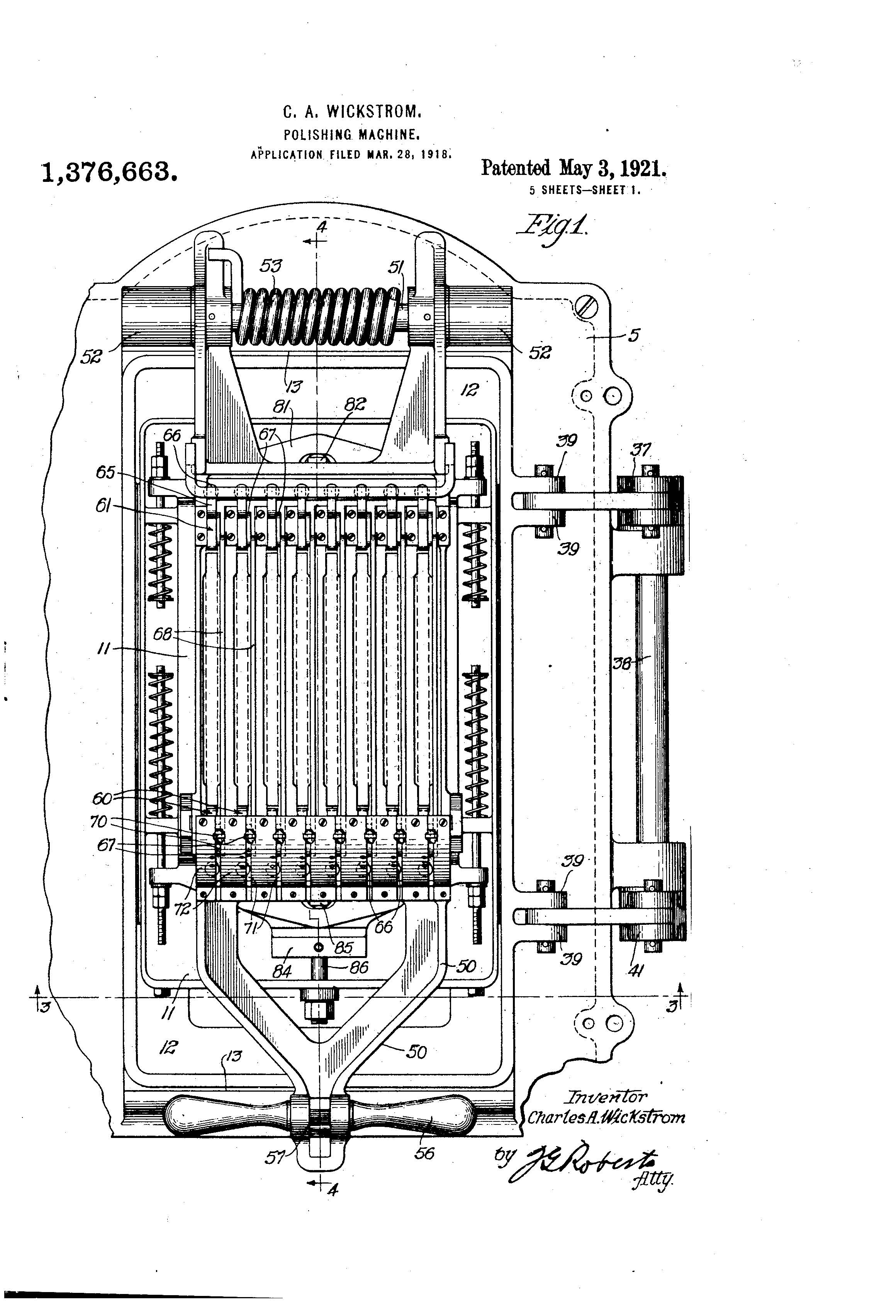
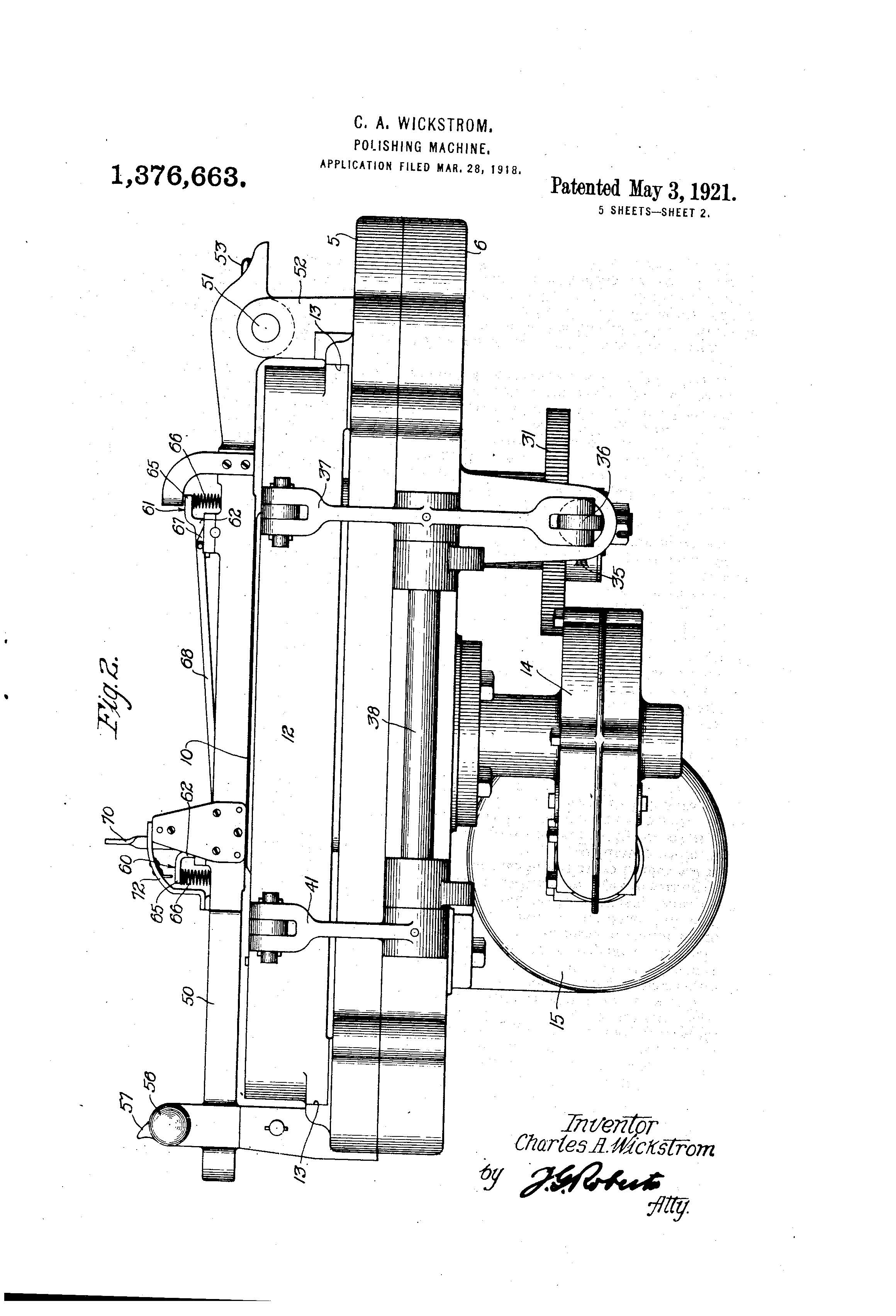

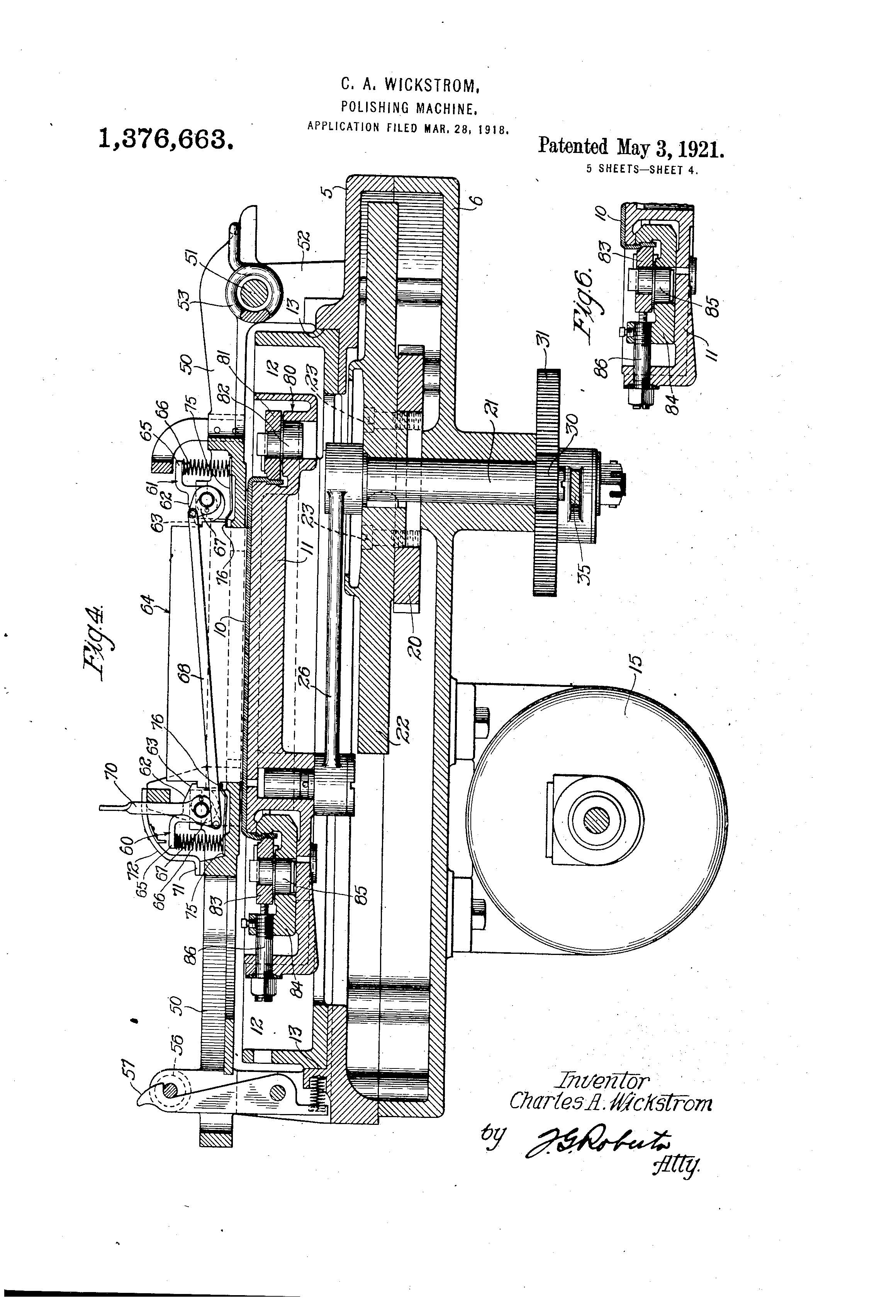
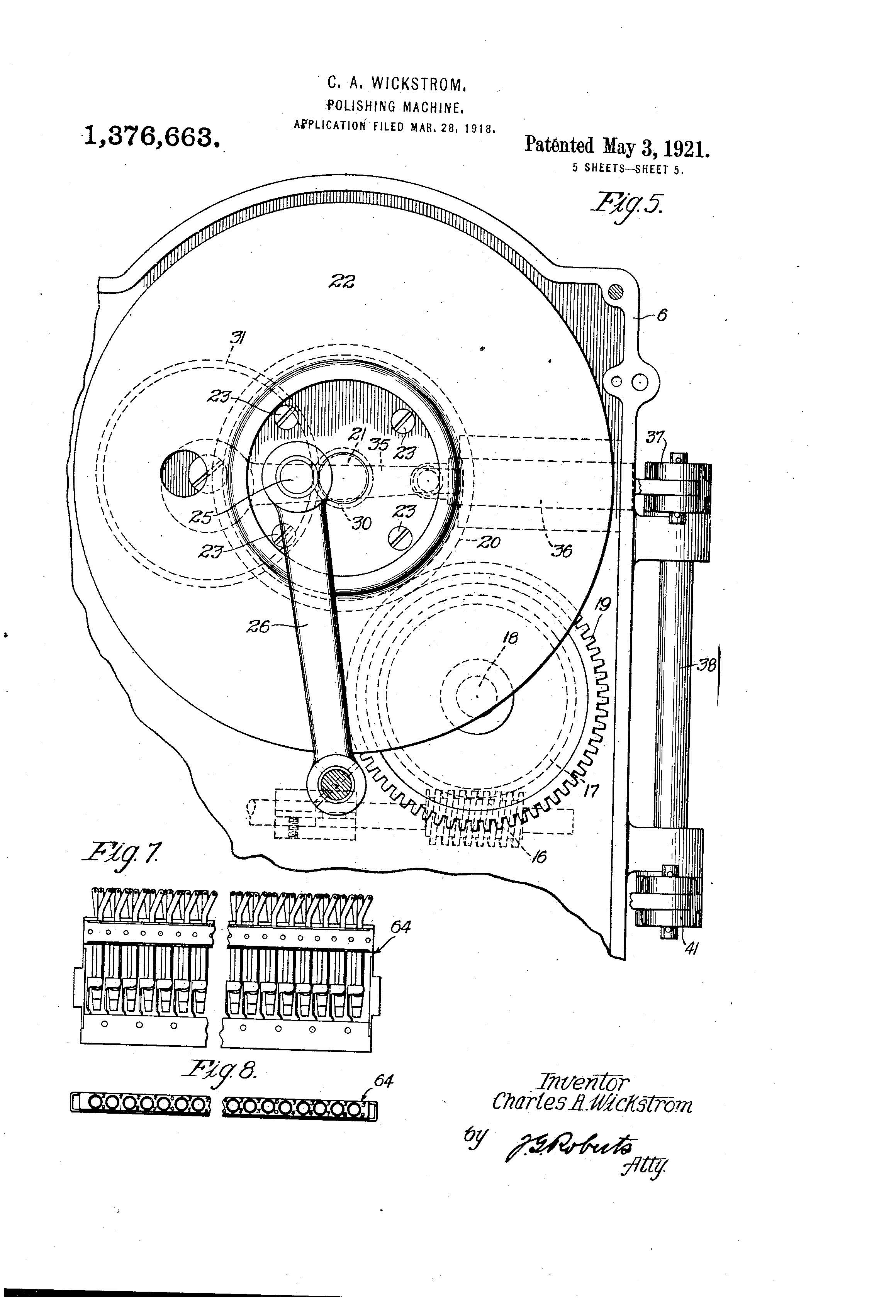
Patent of the Day: Street Cleaning Machine
Suiter Swantz IP takes a look back at past inventions and inventors with our Patent Of The Day.
On this day in 1916, William Erastus Williams was granted U.S. Patent No. 1,181,279 for a STREET CLEANING MACHINE.
The object of this invention is to produce a street cleaning machine that will automatically take up all the material usually found on the street, including small stones and the like and semi-liquid matter, and deposit the same in a carrier box provided on the machine and will when desired, discharge the contents of the box into a vehicle, sacks. or other receptacle provided, or discharge the contents on to a dump therefor.
Suiter Swantz IP is a full-service intellectual property law firm serving all of Nebraska, Iowa and South Dakota. If you have any intellectual property questions or need assistance with any patent, trademark or copyright matters and would like to speak to one of our patent attorneys please feel free to contact us.
